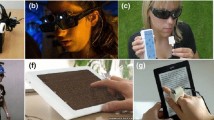Abstract
The paper first summarizes questions related to partial sightedness, followed by the description of programs written in Macromedia Director 8.5. Three game programs are described that can be used to develop the sight of visually impaired children.
The main part of the paper describes a program, which was developed in the framework of ICT, where teachers can upload their materials to the server in a suitable form for normal vision and students can use them according to their special needs. Thus, each student can change the size of the letters, the colour of the letters and of the background, etc. This is a good help for visually impaired children to increase their communication and learning possibilities.
Zusammenfassung
Die Arbeit fasst zuerst Fragen der Sehbehinderungen zusammen, dann werden Programme beschrieben, die mit Macromedia Director 8.5 erstellt wurden. Zuerst behandein die Autoren drei Programme, die von sehbehinderten Kindern als Spiele aufgefasst werden, aber ihre Sehleistung fördern.
Der Hauptteil der Arbeit befasst sich mit einem Programm, das gemäß der Erwartungen von ICT aufgebaut wurde, bei dem der Lehrer sein Unterrichtsmaterial als Normalsichtiger auf den Server aufspielen kann und die Kinder es ihrer Sehbehinderungen entsprechend lesen können. So können sie die Größe der Buchstaben, die Farbe der Buchstaben und des Hintergrundes usw. individuell einstellen. Das ist eine gute Hilfe für sehbehinderte Kinder, um ihre Kommunikations- und Lernmöglichkeiten zu fördern.
Similar content being viewed by others
References
Archambault, D., et al., TIM (2000): Tactile Interactive Multimedia computer games for visually impaired children. May 2000. This project is founded by the European Comission — Information Society Technologies, ref. IST-2000-25298.
Blenkhorn, P. L. (1986): Microcomputer software using a touch sensitive screen. The British Journal of Special Education. December, 4, 161.
Blenkhorn, P. L., Evans, G. (2001): Using a multimedia computer to support visual assessment and training of early visual skills for children with profound and multiple disabilities. Assistive Technologies — Added Value to the Quality of Life, Ĉ. Marinĉcek et al. (Eds.) IOS: 364–368.
Blenkhorn, P. L., Tobin, M. J. (1983): Report on computer hardware in schools and units for the visually handicapped. University of Birmingham, Research Center for the Education of the Visually Handicapped.
Commission Internationale de l’Eclairage. (1997): Lighting needs for the partially sighted. Technical Report on Low-vision. CIE 123: 1997.
Dini, S., Ferlino, L., Martinoli, C. (2004): Usability educational software for visual impairment: A questionary of viewpoint. 9th Int. Conf. Computers Helping People with Special Needs, D. Burger et al. (Eds.) Springer: 575–582.
Feyerer, E. (2002): Computer and inclusive education. 8th Int. Conf. Computers Helping People with Special Needs. W. Zagler et al. (Eds.) Springer: 64–67.
Gulliksen, J., Haker, S. (2004): The software accessibility of human-computer interfaces — ISO Technical Specification 16071. Universal Access in the Information Society, Vol. 3, No. 1: 6–16.
Khan, A. H. M. N., Chowdhury, S. N. (2004): Computer for persons with visually impairment: A door to education, information and employment. 9th Int. Conf. Computers Helping People with Special Needs, D. Burger et al. (Eds.) Springer: 571–574.
Lang, Z. (2000): Multimédia a látásfejlesztésben. Diplomamunka Veszprémi Egyetem. (Multimedia in Development of Vision, MSc Thesis, University of Veszprem)
Kobayashi, M., Watanabe, T. (2002): A tactile display system equipped with a pointing device — MIMIZU. 8th Int. Conf. Computers Helping People with Special Needs, W. Zagler et al. (Eds.) Springer: 527–534.
Molnár, G., Sik Lányi, C., Mátrai, R. (2005): Homepage design for e-learning considering Web Content Accesibility Guidlines (WCAG) for low-vision users. Assistive technologies — from virtualy to reality. A. Pruski, H. Knops (Eds.) IOS: 494–498.
Ruseckaite, R., Lukauskiene, R. (2001): Assistive technologies for children. Restoration of visual perception functions. Assistive technologies — added value to the quality of life, Ĉ. Marinĉek et al. (Eds.) IOS: 369–373.
Sik Lányi, C, Kovács, P., Varga, Z. (1999): Multimedia program for the development of the vision of partially sighted children. 8th Int. Conf. on Human-Computer Interaction: 1014–1017.
Sik Lányi, C., Lányi, Zs. (2003): Multimedia program for training of vision of children. Journal of Information Technology Education, Volume 2: 279–290, http://www.jite.org/documents/Vol2/v2p279-290-28.pdf./
Spencer, S., Ross, M., Tobin, M. J., Blenkhorn, P. L. (1987): Centre Computer Base for Visually handicapped children, students and adults. The British Journal of Visual Impairment, V: 67–69.
Watkins, A., Weber, H. (2002): National Information and Communication Technology Policies — Their Impact upon the Use if ICT in Special Needs Education (SNE). 8th Int. Conf. Computers Helping People with Special Needs, W. Zagler et al. (Eds.) Springer: 68–75.
W3C: Homepage of the World Wide Web Consortium (W3C), http://www.w3.org/.
Author information
Authors and Affiliations
Rights and permissions
About this article
Cite this article
Sik Lányi, C., Mátrai, R., Molnár, G. et al. User interface design for visually impaired children. Elektrotech. Inftech. 122, 488–494 (2005). https://doi.org/10.1007/BF03054386
Published:
Issue Date:
DOI: https://doi.org/10.1007/BF03054386




